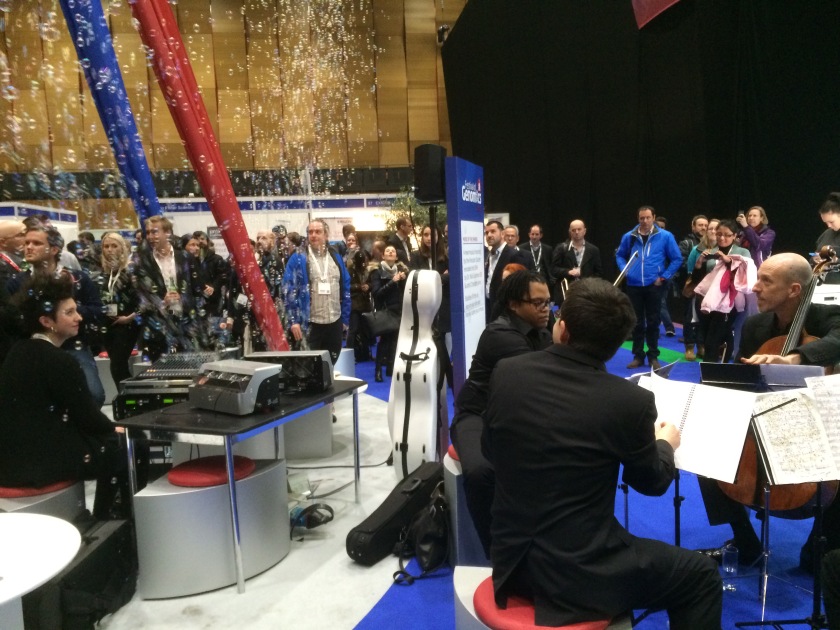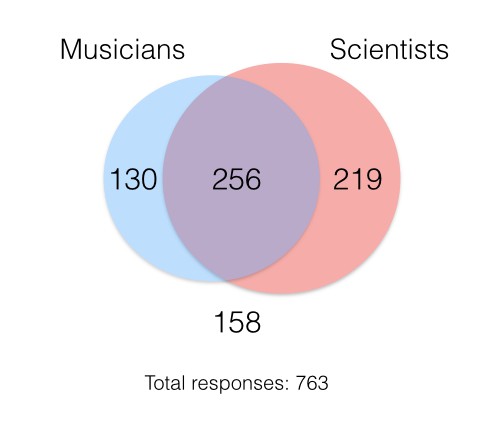This was something I wrote for the “review” assignment of my writing course.
 There is a time and a place for complex atonal music, and perhaps the drinks reception of a genomics conference at the Excel Centre was not it. Through the chatter it wasn’t always easy to hear what the string quartet was doing, and meeting attendees were confused about the performance. “I thought they were still tuning”, said one of the guests.
There is a time and a place for complex atonal music, and perhaps the drinks reception of a genomics conference at the Excel Centre was not it. Through the chatter it wasn’t always easy to hear what the string quartet was doing, and meeting attendees were confused about the performance. “I thought they were still tuning”, said one of the guests.
There was a good reason the Kreutzer Quartet was playing here, at the Festival of Genomics, surrounded by exhibit stands for DNA sequencing companies and clusters of geneticists. Their performance was a crucial part of an art piece by Charlotte Jarvis, which explored the possibilities of encoding complex information in DNA.

The work, Music of the Spheres (named after a Byron poem), combines music, science, and a bubble machine. It requires some effort on the part of the audience to grasp how all the components fit together.
The core of the work is a three-movement musical composition, written by the Kreutzer Quartet, and inspired by DNA. The musicians performed the first and third movements live during a drinks reception at the Festival of Genomics, on January 20th. They used asynchronous glissando scales to express the coiling strands of DNA, and tapped the strings with the wooden part of their bow (col legno) to suggest the sound of large machines handling genetic information.
Movement 2, however, was not performed – at least not by the string quartet. This middle movement was converted into DNA code according to a system developed by Nick Goldman at the European Bioinformatics Institute. He initiated this collaboration with Jarvis to illustrate the enormous potential of using DNA code to digitize large amounts of information: in this case, a recording of the Kreutzer Quartet playing the middle movement of their genetics-inspired piece. This segment of custom-designed DNA was then created and mixed into a soapy solution. So it wasn’t the string quartet playing the middle movement of the piece, but a bubble machine. While the musicians rested, Jarvis switched on the machine, and the music travelled in the air – unheard, but tangible and visible. If you were to capture a bubble, isolate the DNA and sequence it, you might be able to get the data for the recording back out of its unconventional storage format.
 This was not the first performance of Music of the Spheres. It had previously been set up in a large empty building, a gallery along the coast, and Hornsey Town Hall. The string quartet can’t be everywhere, but the bubbles are always there, and form the core part of the work. In fact, Jarvis turned on the bubble machine a few times during breaks at the Festival of Genomics. Without the string quartet, this created an effect of simple party entertainment, not out of place at this conference, which also featured a lively talk show and a treadmill challenge. People engaged with the bubbles by photographing them, popping them, or shielding their coffee cups from soapy surprises. Many of them were unaware that each bubble contained fragments of DNA encoding a piece of music.
This was not the first performance of Music of the Spheres. It had previously been set up in a large empty building, a gallery along the coast, and Hornsey Town Hall. The string quartet can’t be everywhere, but the bubbles are always there, and form the core part of the work. In fact, Jarvis turned on the bubble machine a few times during breaks at the Festival of Genomics. Without the string quartet, this created an effect of simple party entertainment, not out of place at this conference, which also featured a lively talk show and a treadmill challenge. People engaged with the bubbles by photographing them, popping them, or shielding their coffee cups from soapy surprises. Many of them were unaware that each bubble contained fragments of DNA encoding a piece of music.

But while the bubbles alone were a good match for the hectic venue, the live performance unfortunately was not. It seems a shame that the talented Kreutzer Quartet came all the way here to perform for a crowd that could barely hear them and was more interested in catching up with colleagues over a drink.
Music of the Spheres is a work that makes us think about the potential of DNA as a data storage method. It requires thoughtful reflection, and is best experienced against a quiet backdrop – not one of clinking wine glasses and murmuring conversations.



